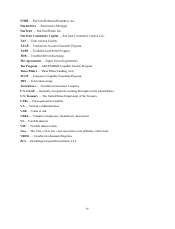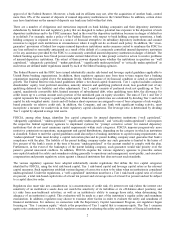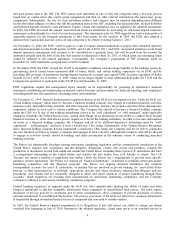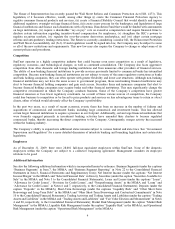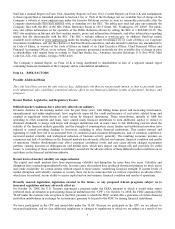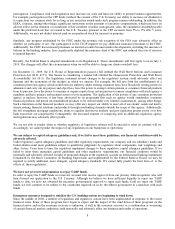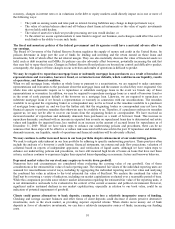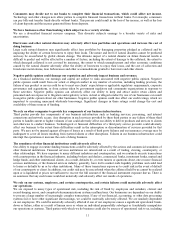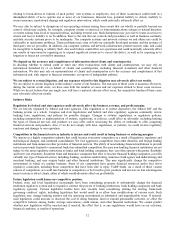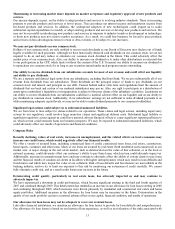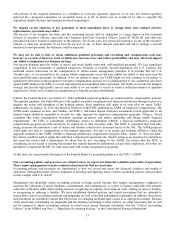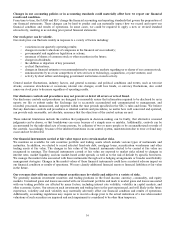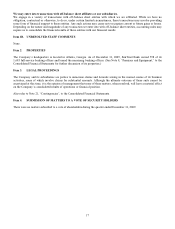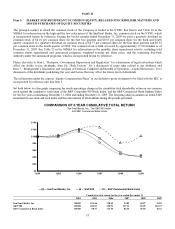SunTrust 2009 Annual Report Download - page 24
Download and view the complete annual report
Please find page 24 of the 2009 SunTrust annual report below. You can navigate through the pages in the report by either clicking on the pages listed below, or by using the keyword search tool below to find specific information within the annual report.participation. Compliance with such regulation may increase our costs and limit our ability to pursue business opportunities.
For example, participation in the CPP limits (without the consent of the U.S. Treasury) our ability to increase our dividend or
to repurchase our common stock for so long as any securities issued under such program remain outstanding. In addition, the
EESA, contains, among other things, significant restrictions on the payment of executive compensation, which may have an
adverse effect on the retention or recruitment of key members of senior management. Also, the cumulative dividend payable
under the preferred stock that we issued to the U.S. Treasury pursuant to the CPP increases from 5% to 9% after 5 years.
Additionally, we may not deduct interest paid on our preferred stock for income tax purposes.
Similarly, any program established by the FDIC under the systemic risk exception of the FDA may adversely affect us
whether we participate or not. Our participation in the TLGP requires we pay additional insurance premiums to the FDIC.
Additionally, the FDIC has increased premiums on insured accounts because market developments, including the increase of
failures in the banking industry, have significantly depleted the insurance fund of the FDIC and reduced the ratio of reserves
to insured deposits.
Recently, the Federal Reserve adopted amendments to its Regulation E. These amendments will first apply to us on July 1,
2010. The changes will affect the circumstances when we will be able to charge our clients overdraft fees.
On December 11, 2009, the U.S. House of Representatives passed a bill entitled the Wall Street Reform and Consumer
Protection Act (H.R. 4173). The Senate is considering a similar bill entitled the Homeowner Protection and Wall Street
Accountability Act (S-3). The legislation contained several changes to the regulatory system could adversely affect our
business and the economies of the markets in which we operate. For example, the bill sets forth the establishment of a
consumer protection agency which would exercise authority under existing consumer laws, have broad rule writing powers to
administer and carry out its purpose and objectives, have the power to exempt certain persons or consumer financial products
from its purview, have the power to examine or require reports from certain persons to ensure compliance with such agency’s
mandates and have primary enforcement action over its mandates. The application of the powers of any consumer protection
agency is unclear; however, it has been advocated by its proponents that such an agency would standardize consumer
financial products and permit un-standardized products to be offered under very limited circumstances, among other things.
Such a limitation on the financial products we may offer may impact our ability to meet all of our clients’ needs and lead to
clients seeking financial solutions and products through nonbanking channels outside the scope of this agency. Additionally,
the bill strengthens mortgage regulations, seeks to regulate derivatives markets and give regulators greater power over how
bank executives are compensated. Consequently, the increased expense of complying with an additional regulatory agency
and regulations may adversely affect profits.
We are not able to predict when or whether regulatory or legislative reforms will be enacted or what its contents will be.
Accordingly, we cannot predict the impact of any legislation on our businesses or operations.
We are subject to capital adequacy guidelines and, if we fail to meet these guidelines, our financial condition would be
adversely affected.
Under regulatory capital adequacy guidelines and other regulatory requirements, our company and our subsidiary banks and
broker-dealers must meet guidelines subject to qualitative judgments by regulators about components, risk weightings and
other factors. From time to time, the regulators implement changes to these regulatory capital adequacy guidelines. If we
failed to meet these minimum capital guidelines and other regulatory requirements, our financial condition would be
materially and adversely affected. In light of proposed changes in the regulatory accords on international banking institutions
formulated by the Basel Committee on Banking Supervision and implemented by the Federal Reserve Board, we may be
required to satisfy additional, more stringent, capital adequacy standards. We cannot fully predict the final form of, or the
effects of, these regulations.
We have not yet received permission to repay TARP funds.
In order to repay the TARP funds we received, we must first receive approval from our primary federal regulator who will
then forward our application to the U.S. Treasury. Although we believe we have sufficient liquidity to repay our TARP
funds, to date, we have not obtained the necessary governmental approval to repay such funds. Until we repay our TARP
funds, we will continue to be subject to the constraints imposed on us by the federal government in connection with such
funds.
Emergency measures designed to stabilize the U.S. banking system are beginning to wind down.
Since the middle of 2008, a number of legislation and regulatory actions have been implemented in response to the recent
financial crisis. Some of these programs have begun to expire and the impact of the wind down of these programs on the
financial sector and on the economic recovery is unknown. A stall in the economic recovery or a continuation or worsening
of current financial market conditions could materially and adversely affect our business and results of operations.
8




